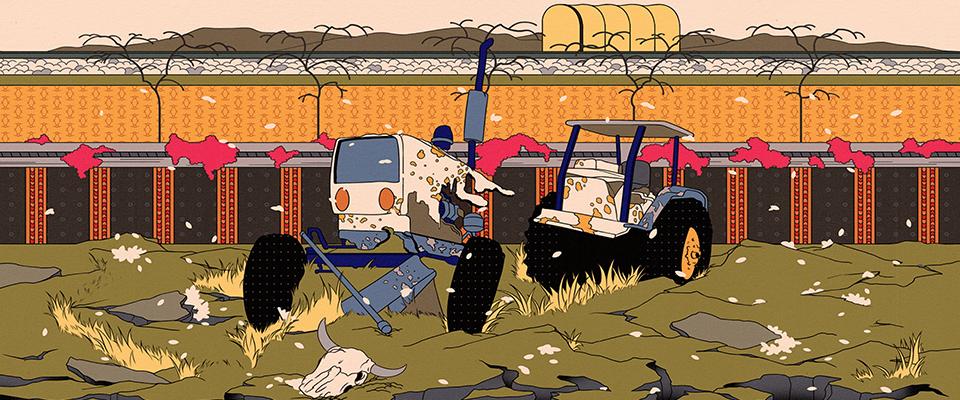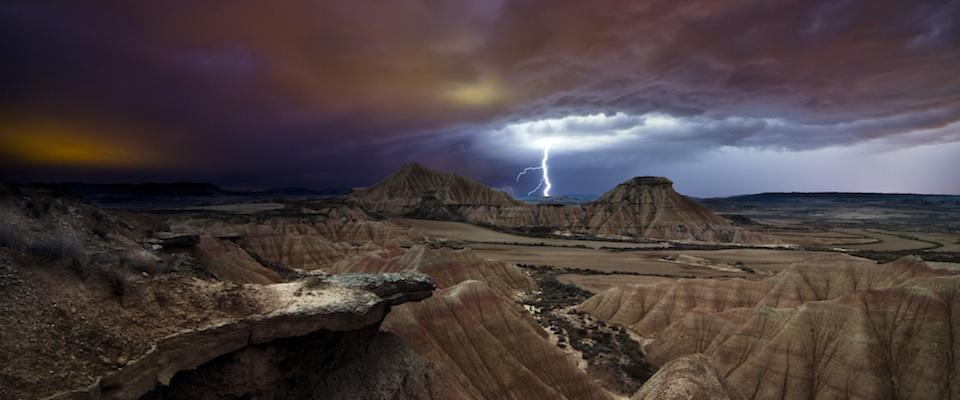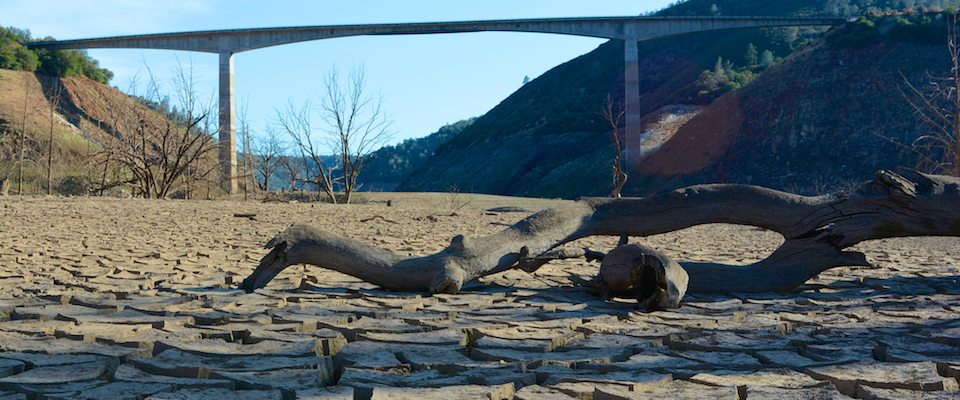Berkeley paleoclimatologist Lynn Ingram has been getting a lot of ink and bandwidth in recent days, and rightly so. Her analyses of the drought now bedeviling California conclude the current “rainy” season could be the driest of the past 500 years.
Further, Ingram’s research (focused on sediments, archaeological sites, and tree rings) indicates we ain’t seen nothin’ yet, probably. “People” time is, from the planet’s perspective, accelerated time; we are almost as evanescent as clouds. But the state’s climate cycles on geologic time. And over the past several thousand years, California has been gripped by vicious droughts that have lasted for decades. Some endured for more than a century.
Indeed, says Ingram, the 20th century—the span during which California transformed from a lightly populated agricultural backwater (albeit with a mother lode of gold in the Sierra Nevada) into the teeming urbanized state it is today—was something of an outlier, a period characterized by relatively abundant precipitation and mercifully short dry spells. When California magazine spoke with her several months ago about her study of historic weather patterns, she presciently warned that the state should brace for more extreme weather conditions to come.
The current drought, which may be exacerbated by climate change, could be a signal that we’re returning to a drier cycle.
That’s sobering, as well as desiccating, for a very basic reason. The last 100 years may have been comparatively wet, but they were still pretty darn dry. In an average year, California receives about 30 million acre feet of usable water, mostly deposited as snow in the Sierra Nevada and Trinity/Klamath mountains. Given that an acre foot is 325,000 gallons, that may seem like a lot. But there are more than 38 million people in the state and all of them like long showers and flushing their toilets regularly. Further, agriculture is one of California’s economic drivers, and it sucks up a lot of water—70 to 80 percent of the developed supply, in fact.
So bottom line, there isn’t that much water to go around. To a very real degree, we were in a water crisis before the current drought. Demand from cities, farms, and environmentalists lobbying for fisheries flows exceeded the available reserves.
OK. It’s enough to make you break out in a sweat. But what can we do about it? A fair amount, as it turns out, says Heather Cooley, co-director of the water program at Oakland’s Pacific Institute and a former researcher in climate, land use, and carbon cycling at Lawrence Berkeley Lab. Make no mistake, though: Thinking we’ll ever go back to business as usual is a pipe dream. The Age of Limits is here to stay.
“There will be pain,” says Cooley. “We were already hard pressed to meet water needs and maintain water quality before this drought, and this just makes the challenge even greater. We do, however, have some opportunities we can exploit.”
Stemming waste is foremost among them. Water may be scarce, but we still go through it like drunken sailors. Yes, we’ll all have to take shorter showers as we did during the last major drought (1976–77). But that’s not enough.
“We have to move beyond behavioral response to long-term efficiencies,” says Cooley. “Low-flow toilets and clothes washers are now required for new developments in the Los Angeles area, but that doesn’t address all the older homes that have less efficient devices. For that matter, even the toilets and washers now generally installed reflect codes from the 1990s. We have a lot better designs now, and we should use them.”
That has been difficult to do, Cooley says, because states weren’t allowed to exceed federal standards on low-flow devices until recently.
“But a 2010 rule change now allows states to designate more rigorous standards,” Cooley says, “so the current situation might accelerate demands for an update.”
Landscaping is another big opportunity for water savings—and that could mean killing your lawn. “Lawns require a great deal of water, and we may have to conclude California is an inappropriate place to grow them,” says Cooley. “Xeriscaping (the use of plants that require little or no irrigation) makes a lot more sense.”
“Lawns require a great deal of water, and we may have to conclude California is an inappropriate place to grow them,” says Cooley. “Xeriscaping (the use of plants that require little or no irrigation) makes a lot more sense.”
Cooley also says farmers need to increase their use of drip-irrigation systems and micro-sprinklers.
“There’re also new technologies we can employ that tell farmers the best time to irrigate,” Cooley says. “They monitor soil moisture and weather conditions, and are a much more efficient way to determine irrigation schedules than merely gauging the ‘look’ of the crops.”
Many environmentalists want to go further, however, pushing for the retirement of hundreds of thousands of acres of croplands in the western San Joaquin Valley. The “Westside” uses millions of acre feet of water in a typical year and, as a by-product, produces copious quantities of selenium-tainted drainwater that imperils fish and wildlife. Land retirement proponents observe that most of the land could be bought for around $10 billion, converted to dry land grazing or wildlife habitat, and the water returned to urban and environmental uses.
Cooley agrees that land retirement must be part of any effective drought response. Further, she notes that the recent Central Valley boom in almond and walnut plantings are putting additional stress on water supplies, because such permanent orchards require far more water than most annual vegetable and commodity crops.
“I think we’ll see land fallowed and some orchards come out,” says Cooley. “There will, of course, be impacts on the economy and labor, and that’s going to cause a response. It’s a difficult situation.”
Exacerbating agriculture’s dilemma is groundwater. Or rather, the lack of it.
“Groundwater is a huge issue,” Cooley says. “It’s an important reservoir for California, especially during droughts, when there’s no surface water available. The problem is that we’re drawing it down faster than it can recharge. San Joaquin Valley growers aggressively tapped their groundwater reserves during the 2007–2009 drought. That helped pull them through, but we saw huge declines in San Joaquin Valley aquifers. They simply haven’t replenished, and now farmers won’t be able to rely on them. That’s going to really hurt.”
There’s more we can do to extend the supplies we have, says Cooley. Rigorous conservation is a given, but we’ll also have to consider recycling (someday our sewage may come back to us—thoroughly processed and purified, of course—through our taps). Another strategy may involve desalinating salty groundwater, which is usually found at greater depths than sweet water and has until now been regarded more as a complication for oil drilling than as a fairly abundant water resource.
A final response we may want to reconsider: huge public works schemes like the Bay Delta Conservation Plan, a project promoted by the Brown administration that would construct two tunnels under the Sacramento/San Joaquin Delta to optimize water shipments to Southern California. Proponents say the tunnels will improve the southern region’s water access and security. Opponents maintain it’s a waste of money, in that it is only designed to convey water, not produce extra supplies. Cooley expresses significant reservations about the project, particularly as it affects the San Francisco Bay–Delta estuary.
“As proposed, the tunnels are very large and they could take a lot of water out of the Delta,” she says. “We’re already diverting too much water from the system. We know that’s one of the major reasons for its (ecological) decline. There are just a lot of issues with the project that are unresolved.”
For more on why, if the past is any indication, California is in for some grueling weather conditions, see this story from our Summer 2013 issue.




















